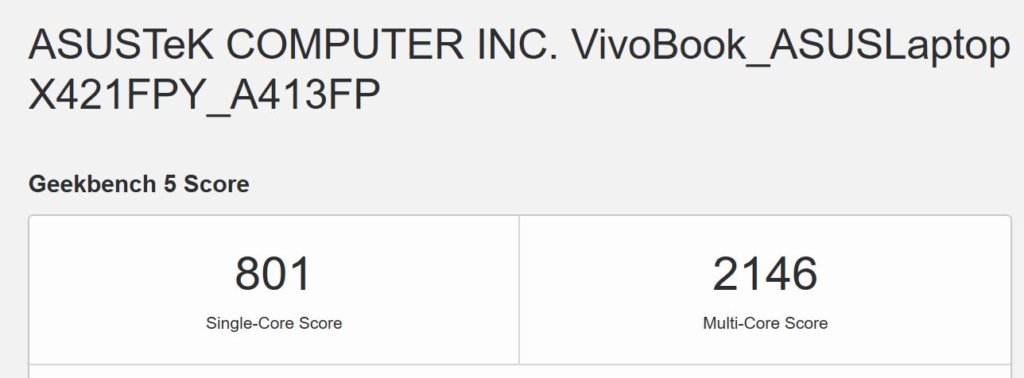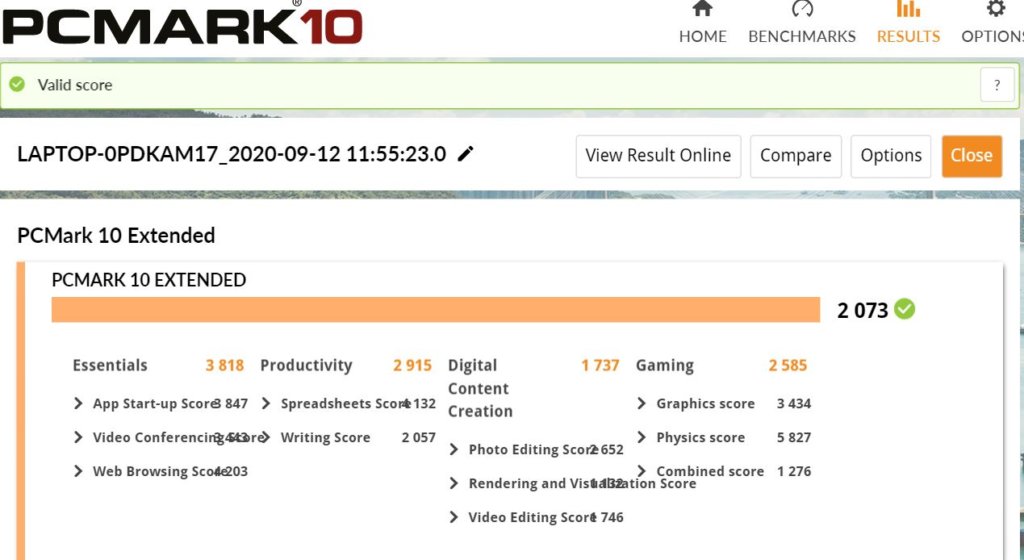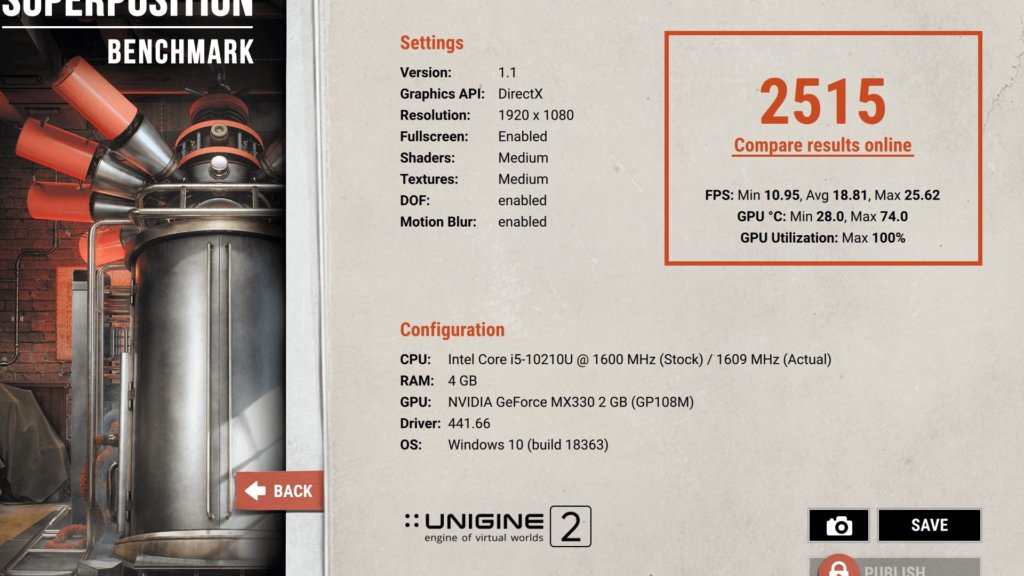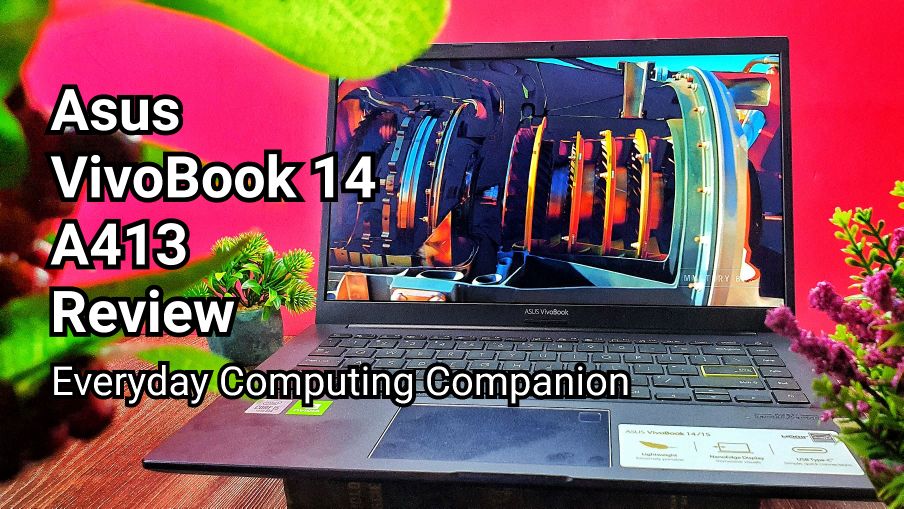
ASUS VivoBook 14 A413 Review – Your EveryDay Cool Computing Companion
Not everyone needs to drive a sports car. For a great many out there adjusting to the new normal, they need a reliable ride that can get you from point A to B with a minimum of fuss which is exactly what the latest incarnation of the ASUS VivoBook 14 A413 laptop is about as it features enough performance and portability at a fair enough price point that it makes for a decent workhorse without having to give an arm and a leg.
The successor to last year’s VivoBook Ultra A412 that we had the pleasure to review, the new VivoBook 14 A413 has much of the DNA of its predecessor with a mission profile intended for everyday computing.
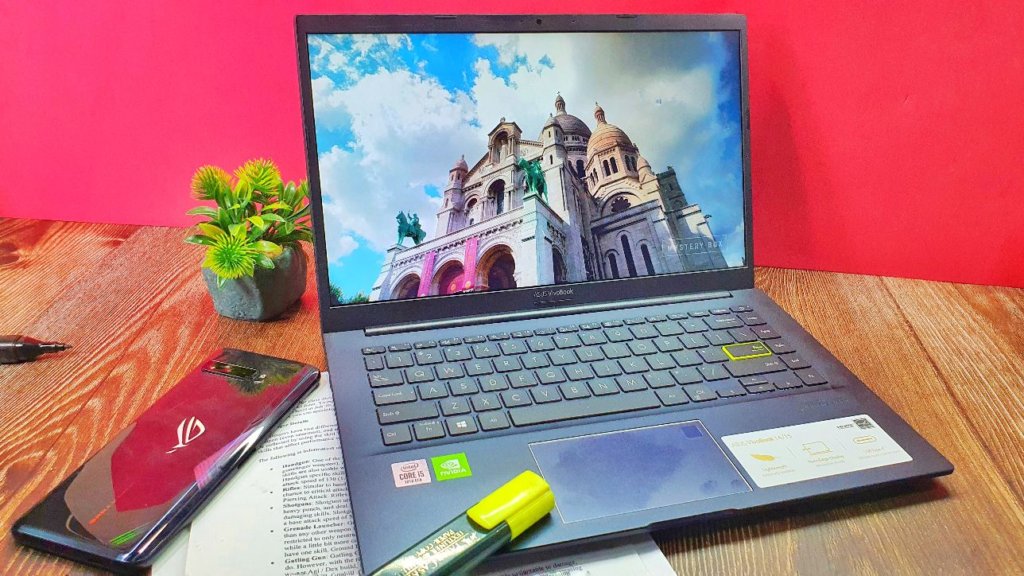
The latest incarnation offers refinements in design and portability combined with the customary refresh in terms of the hardware to match this year’s current generation of processors and graphics cards with a bump up to 10th Gen Intel Core processors and a refresh of the GPU to an NVIDIA GeForce MX330.
Out of the box, ASUS has thrown in quite an eclectic bunch of extra bonuses. Bundled with the ASUS VivoBook 14 A413 is a free backpack, the obligatory user manual and warranty card, the charger, the notebook itself and, oddly enough, a sheaf of stickers for you to personalise your rig.
Perhaps the most important freebie of all is that ASUS is also throwing in a free lifetime license of Microsoft Office Home and Student 2019 with every VivoBook 14 A413 sold.
ASUS VivoBook 14 A413 Design
Table of Contents
The laptop is a 14-inch laptop done up in a matte shade of black that they’ve dubbed as Bespoke Black though you can acquire it in a lighter shade of Cobalt Blue.
While the entirety of the chassis is made of polycarbonate, the matte black finish of our test unit lends it a classier look that belies its asking price though its nature is immediately apparent when you hold it in your hands.
There’s a slight bit of give in the centre of the top lid if you prod it hard enough and there’s some give and play on the corners but the rest of the chassis is otherwise soundly built with modest resistance to fingerprints on account of the matte black finish. The top lid itself is otherwise plain save for the ASUS VivoBook logo done up in silver.
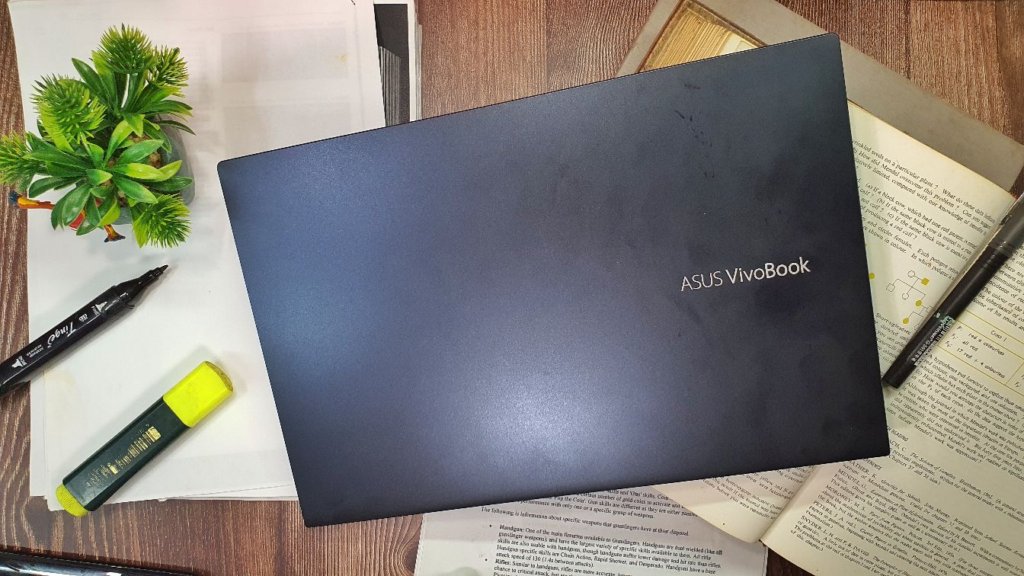
Both the left and right sides of the laptop have a rather diverse array of ports that covers almost all scenarios that an executive or student would encounter.
On the left side you get the DC-IN jack, a HDMI 1.4 port, a USB 3.2 Gen 1 Type A port , a USB 3.2 Gen 1 Type-C port and a 3.5mm headphone jack. The right side hosts a pair of USB 2.0 Type-A ports for conventional peripherals like keyboards, mice and the like as well as a microSD card reader.
The bottom of the notebook is all done up in polycarbonate with a quartet of rubber feet and a series of Philips screws to keep it sealed.
Closer inspection reveals a hinge with a conventional design rather than the Ergolift hinges that appear on their other product lines. To ensure proper ventilation on its underside, the laptop is reliant on its four rubber feet to keep enough clearance for air to flow through.
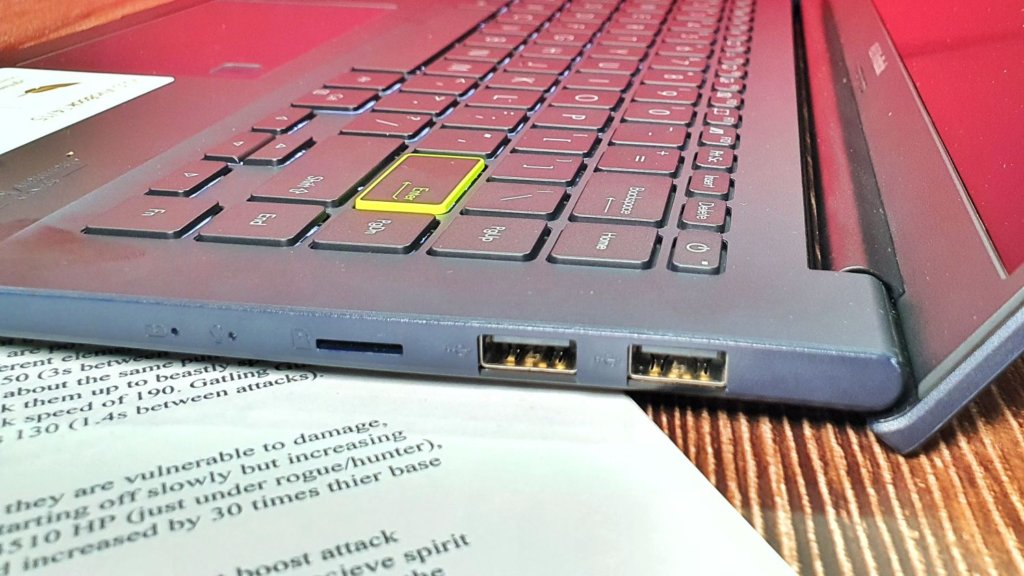
Opening the VivoBook 14 A413 is somewhat of a challenge as the hinges are a bit stiff. While an indent is cut out at the base of the laptop for your fingers to gain purchase, there’s still a lot of friction so you’ll need two hands to open it.
The display itself is a 14-inch Full HD panel with exceptionally slim side bezels, which allows ASUS to cram the display into what is effectively a 13-inch form factor though the top and bottom bezels are still a bit on the chunky side.
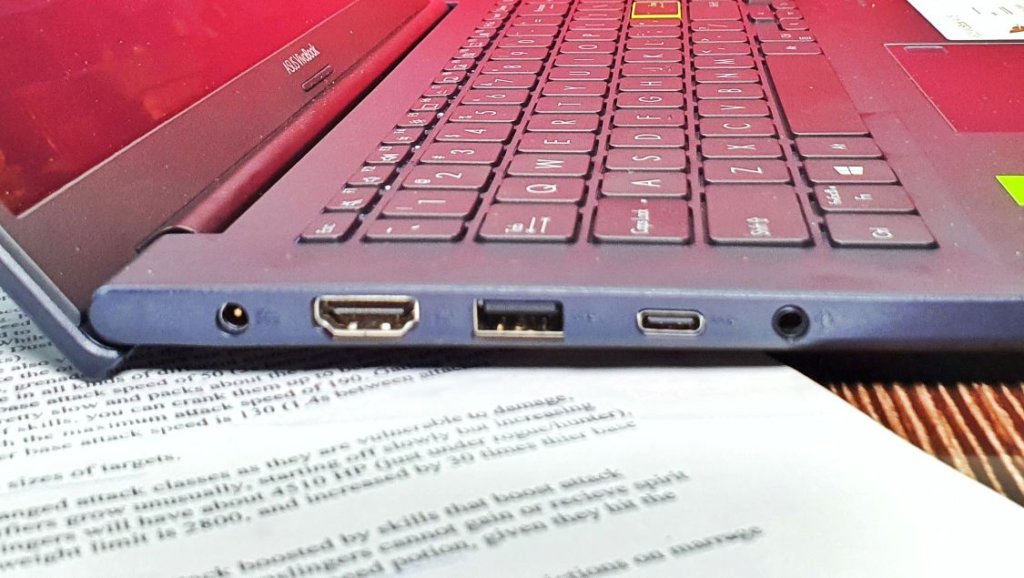
The keyboard itself is a chiclet-style compact version with white backlighting. The layout is fairly standard with the notable addition of a vertical row of function keys on the right side along with an Enter key that’s oddly enough highlighted in neon green trim.
Keyboard aside, the VivoBook 14 A413 sports a basic touchpad unlike the NumPad and ScreenPad gracing their higher end models. It’s also a bit on the small side but it does have the added bonus of a fingerprint reader for better security.
Minor foibles aside, the VivoBook 14 A413 is sturdily built for what you pay for and is sufficiently robust enough to survive being toted around in a backpack on a day to day basis for lectures, work meetings, presentations and the like.
One thing to note though is that the laptop is not MIL-STD810G rated like their higher end ZenBooks and other laptops so you’ll need to take heed for all the usual hazards that would befall a laptop like getting hit by water (and stray cups of coffee), rain and pranging it on the ground. On the bright side, ASUS is throwing in a free backpack to go with it, which mitigates these hazards somewhat.
ASUS VivoBook 14 A413 Specifications and Benchmarks
Much like its predecessor, the VivoBook 14 A413 has an array of hardware optimised for general computing duties. For your money, you’re getting the following:
| Price | RM2,899 |
| Display | 14-inch LCD, 1920 x 1080 pixels, 200 nits, 84% screen-to-body ratio |
| Processor | Intel Core i5-10210U 1.6GHz |
| OS | Windows 10 Home |
| Graphics | NVIDIA GeForce MX330 w/ 2GB GDDR5 VRAM |
| Memory | 4GB DDR4 RAM/ 512GB NVMe PCIe 3.0 SSD |
| Battery | 42WHr, 3-cell Li-iOn |
| Size/Weight | 1.4kg |
A particular bonus is that the laptop has WiFi 6 (Gig+) 802.11ax and Bluetooth 5.0 (Dual band) 2 x 2 support along with an additional SSD bay for you to upgrade the storage. Unfortunately, the 4GB DDR4 RAM provided with the laptop is soldered in and there’s no means to swap it out or add more which bottlenecks its performance.
A particular bonus is that the laptop has WiFi 6 (Gig+) 802.11ax and Bluetooth 5.0 (Dual band) 2 x 2 support along with an additional SSD bay for you to upgrade the storage. Unfortunately, the 4GB DDR4 RAM provided with the laptop is soldered in and there’s no means to swap it out or add more which bottlenecks its performance.
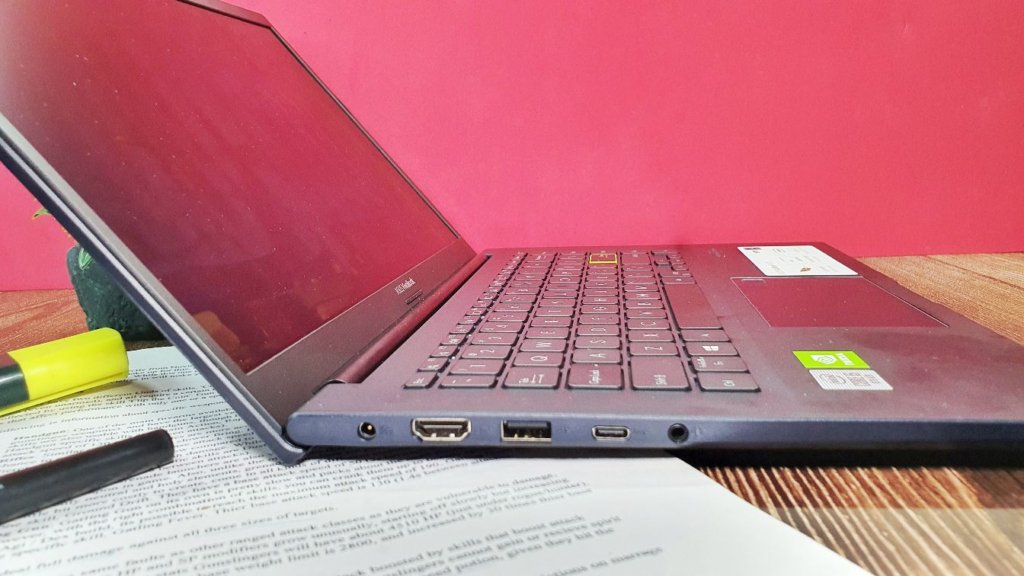
The 10th Gen Intel Core i5-10210U 1.6GHz processor is a low voltage variant designed for ultraportables while the provided NVIDIA GeForce MX330 graphics card is built on a 14nm process and is an entry level solution based on the older GeForce MX250 with an improved clock speed of 1.531MHz versus the MX250’s 1.519MHz clock speed.
Both also have a TDP of 25W so both function within the same performance envelope with the MX330 edging out slightly in the performance stakes on account of the slightly higher clock speed.
When subjected to synthetic benchmarks, the VivoBook 14 A413 scored the following benchmarks. Due to the limited 2GB GDDR5 VRAM allocated to the MX330, it faltered on some of the more demanding benchmarks like 3DMark’s Time Spy Extreme and the more demanding tests in Unigine’s Superposition.
Here are the benchmarks with performance set to maximum and the laptop plugged in:
| 3DMark Time Spy | 1061 |
| 3DMark Time Spy Extreme | 238 |
| PCMark 10 Extended | 2073 |
| Geekbench 5 Single Core Score | 801 |
| Geekbench 5 Multi Core Score | 2146 |
| Cinebench R20 | 170 |
| Unigine Superposition 720P low | 4763 |
| Unigine Superposition 1080P medium | 2515 |
The VivoBook 14 A413 is ideally suited for tackling general computing tasks. It was able to comfortably tab between a dozen open Chrome browser tabs without significant lag, handle word processing and spreadsheets on Google Docs without issue. It was able to handle some basic photo editing too though video editing and gaming is not its strong suite.
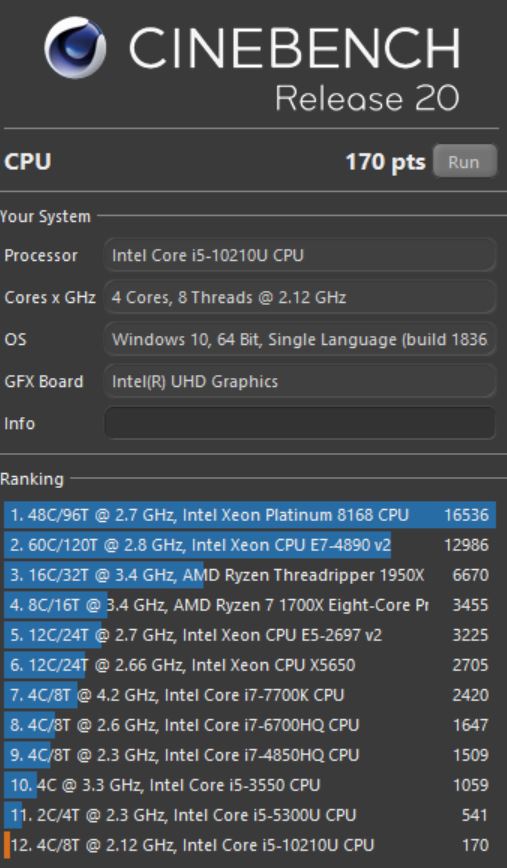
The modest amount of RAM and VRAM on the laptop bottleneck its potential and even the likes of an old game like Saints Row 3 was only able to run at 720P on low settings though it was able to run less demanding games like Stardew Valley and Terraria smoothly.
The provided webcam nestled at the top of the display and bundled speakers is sufficient for use on Zoom and Microsoft Teams for work calls and online lectures though the webcam doesn’t perform all too well in dim lighting. One workaround is adding in a cheap ring light and clipping it to the top of the display which solves the problem nicely.
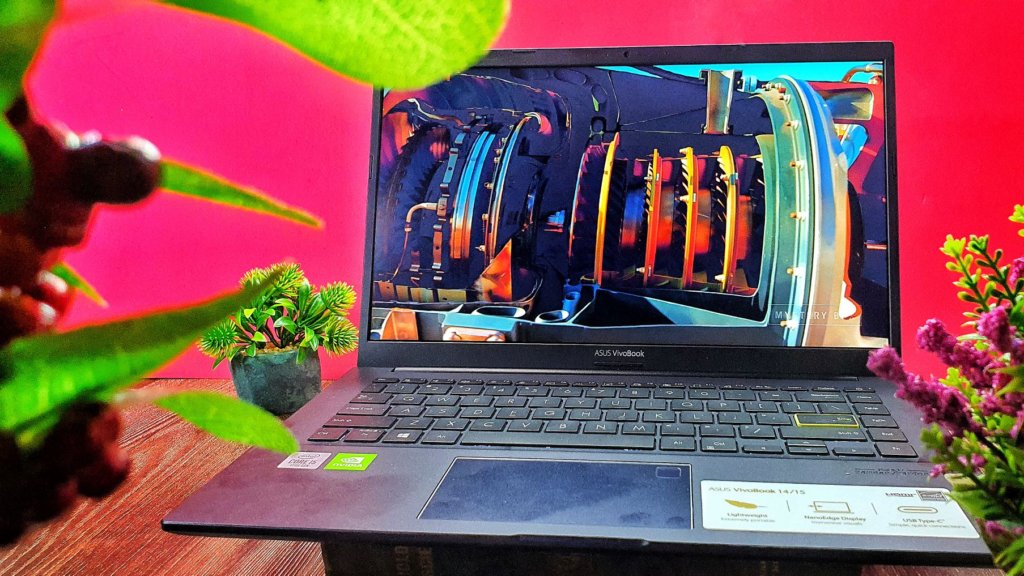
The integrated keyboard takes a bit of getting used to on account of the addition of the row of function keys (Home, Page Up, Page Down, End and Fn) added to the right side but the otherwise standard layout makes getting accustomed to it relatively easy.
After a few days, we managed to get a decent 100wpm out of it. The provided backlighting, once a luxury in older generation VivoBooks, is bright enough that you’re able to easily get about even in dim light.
One quibble we have though is the small size of the touchpad. If it was a wee bit wider, it would have made for a fantastic user experience. On the bright side, it’s fast, responsive and the oleophobic coating makes gliding your fingers on it an easy task.
Asus VivoBook 14 A413 Display and Speakers
The 14-inch Full HD display on the VivoBook 14 A413 has a 16:9 aspect ratio and a modest brightness of 200 nits which is typical of laptops in its size and price range. Clarity and colour rendition are on the ball, though colour rendition with the stock settings seems a bit muted.
Fortunately, you can use ASUS’s MyASUS app to tweak the settings to a more vibrant Vivid setting or you can calibrate it to a colder or warmer colour setting by manually dialling a slider.
You can also set it to an Eye Care mode that reduces blue light emissions with the tradeoff of a warmer yellow tint on the screen. Eye Care mode comes in handy if you have to pore through a tonof documents and spreadsheets though it’s not advisable if you’re watching videos as visuals end up with a sepia tint.
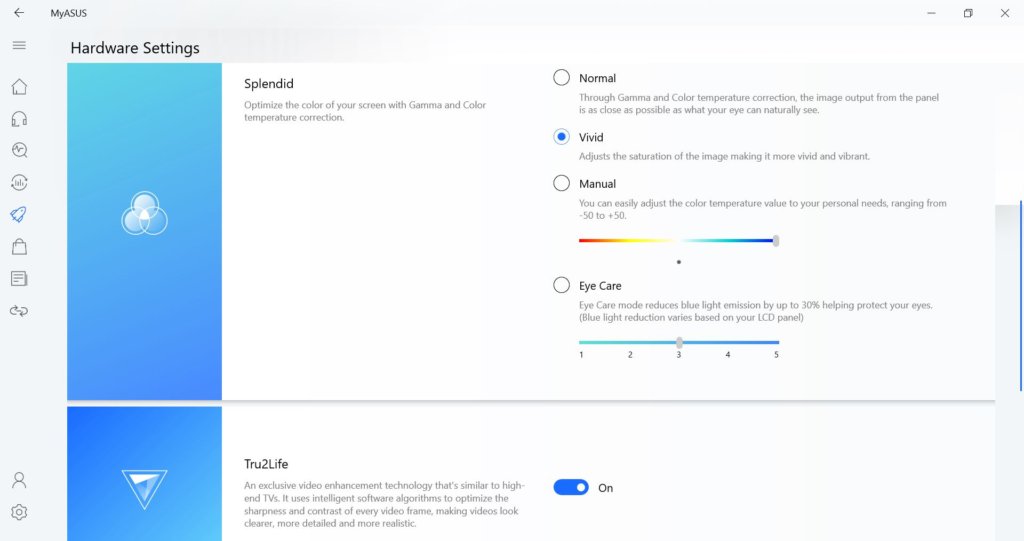
Onscreen brightness is serviceable for indoors use and the screen has decent viewing angles though the 200 nits doesn’t quite cut it for outdoors use. In the confines of offices and lecture theaters and libraries, it’s more than sufficient for the job.
The provided speakers are loud enough for a quiet room and are sufficient for a classroom or office presentation and, if you’re clocking off, a Netflix and chill session though it’s not loud enough for use in any public venue like your usual Starbucks though you can opt for the 3.5mm audio jack for private listening.
ASUS VivoBook 14 A413 Battery Life
The ASUS VivoBook 14 A413F has a 3-cell Lithium Ion battery with 42WHr which is larger than what was on the A412 last year though battery life isn’t measurably improved by a significant margin.
In our PCMark 8 Battery Life test with performance mode set to maximum and screen brightness set to about full and with the benchmark toggled to a Creative work profile, it only managed to last under 2 hours at 1 hour 49 minutes.
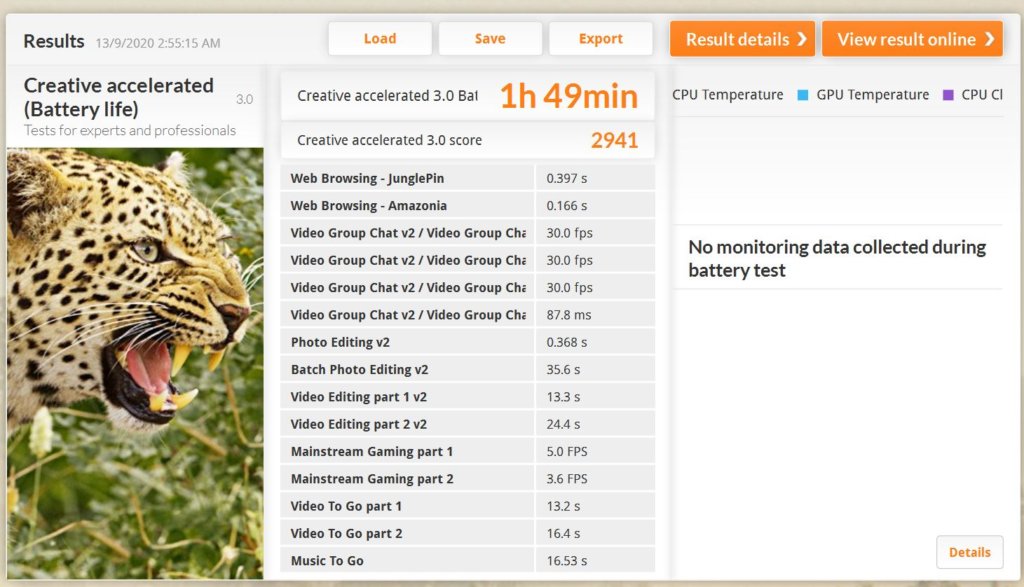
It doesn’t fare all too well away from the mains but if you nurse it by reducing screen brightness down to about 50% and keep yourself doing web browsing, word processing and, mayhaps a quick spot or two of Spotify or YouTube, you can look at about 5 hours of active use time.
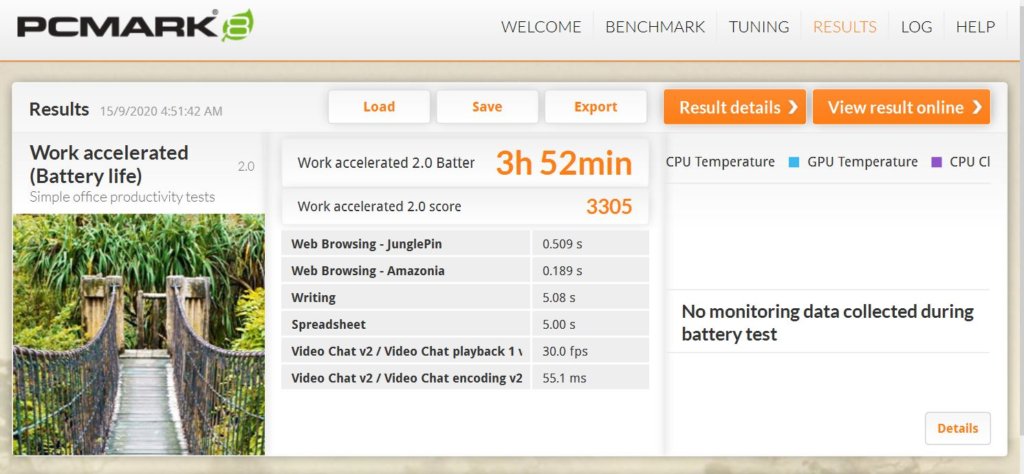
Charging it from dead zero takes a couple of hours. If your work routine is primarily around campus or in the office with short forays out for meetings and presentations, this is almost a non-issue and you’re quite easily able to keep it charged through the day.
For those who are prone to keeping it constantly plugged in, the MyAsus app even has a setting for that which caps battery charging at 60% if you’re constantly hooked up to minimise wear and tear on the battery.
ASUS VivoBook 14 A413 Verdict
The ASUS VivoBook 14 A413 is an entry level 14-inch ultraportable with specifications sufficient for everyday general computing with fair performance in all areas.
It won’t beat higher profile and pricier laptops like the ASUS ZenBook series or ASUS’s premier ultraportable, the ExpertBook B9, but for what you pay for you’re getting a workhorse that can get your coursework done, your spreadsheets and emails sorted and let you browse the web, catch Netflix and otherwise stay connected in the new normal.
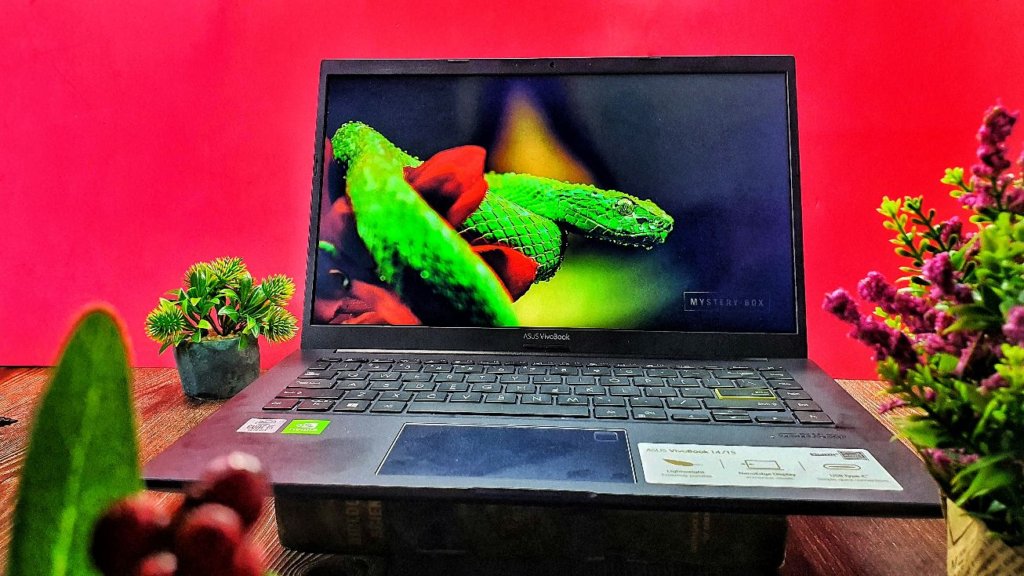
Power users will balk at the lack of upgradeable RAM but for others, the option to add in an additional SSD drive to store pictures, movies and coursework makes up for it.
If you’re after a competent workhorse that gets the job done, the VivoBook 14 A413 is a decent choice though those looking for something more powerful can take a look at their VivoBook S15 S533A which has double the RAM, Intel Optane memory and a slightly higher price tag.
What we liked Decent backlit keyboard, additional SSD bay for expansion, WiFi 6 connectivity, compact size, good build quality, good variety of ports
What we didn’t Small amount of RAM soldered in, screen a bit dim, battery life can be better
We Say The ASUS VivoBook A413 is an entry level 14-inch ultraportable with specifications sufficient for everyday general computing with fair performance in all areas. You’re getting a workhorse that can get your coursework done, your spreadsheets and emails sorted and let you browse the web, catch Netflix and otherwise stay connected in the new normal.
Review unit courtesy of ASUS Malaysia. Available for purchase online at ASUS official page at https://www.asus.com/my/
ASUS Vivobook 14 A413
-
Display
-
Performance
-
Design
-
Value
-
Portability
-
Battery Life
ASUS Vivobook 14 A413
The ASUS VivoBook 14 A413 is an entry level 14-inch ultraportable with specifications sufficient for everyday general computing with fair performance in all areas. You’re getting a workhorse that can get your coursework done, your spreadsheets and emails sorted and let you browse the web, catch Netflix and otherwise stay connected in the new normal.

